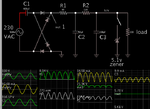Mithun_K_Das
Advanced Member level 3
- Joined
- Apr 24, 2010
- Messages
- 899
- Helped
- 24
- Reputation
- 48
- Reaction score
- 26
- Trophy points
- 1,318
- Location
- Dhaka, Bangladesh, Bangladesh
- Activity points
- 8,252
Help required in Transformer less power supply. I use this power supply for a small product where load is only 50mA at 5V. Without load voltage is around 5.6V and with load 4.8V. Circuit works fine only one problem happens each time.
The zener diode. Zener diode damages frequently. Specially when a spike comes.

How can I improve this circuit so that zener diode become stable. Also size of the total circuit is a matter. I can not use many components.
*** Circuit must be with common phase. So it may be looking odd but it works the best with few components.
The zener diode. Zener diode damages frequently. Specially when a spike comes.

How can I improve this circuit so that zener diode become stable. Also size of the total circuit is a matter. I can not use many components.
*** Circuit must be with common phase. So it may be looking odd but it works the best with few components.

